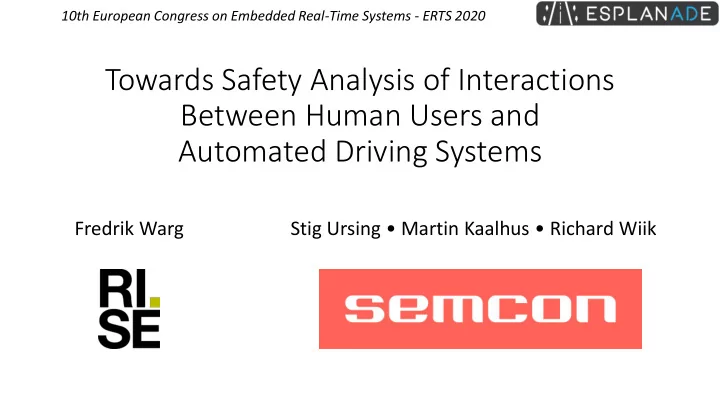

10th European Congress on Embedded Real-Time Systems - ERTS 2020 Towards Safety Analysis of Interactions Between Human Users and Automated Driving Systems Fredrik Warg Stig Ursing • Martin Kaalhus • Richard Wiik
Safety of Automated Driving Systems Need to argue that an ADS feature is sufficiently safe prior to release The automated driving system (ADS) must drive safely while in control Safe interaction with human users (HU) Note : Terminology used mainly from SAE J3016 ” Taxonomy and Definitions for Terms Related to Driving Automation Systems for On- Road Motor Vehicles” Photo: Volvo Cars
Transitions of control between ADS and HU Passenger Remote operation Vehicle with ADS feature dispatcher * (Human) Driver * Focus in this presentation: Transitions of control E.g. Highway pilot between human user and high driving automation feature (SAE Level 4) in a moving vehicle. *Icon made by Freepik from www.flaticon.com
Transition Hazards Mode confusion Unfair transition Stuck in transition ADS Belief HU ADS ADS ADS None HU Belief In control HU HU ? Car photo created by yanalya - www.freepik.com ADS and HU do not share ADS or HU forced to take ADS or HU unable to belief of who is driving. control when not prepared complete transition in time, and able to drive. impairing driving capability. Ref: Johansson et al. ”Safe Transitions of Responsibility in Highly Automated Driving”, 2016 and ” Safe Transitions Between a Driver and an Automated Driving System ”, 2017.
Safe Transitions Previous work: Transition hazards Principles for safe handover Safety analysis for a transition protocol In this work: Propose method to perform safety analysis combining practices from functional safety and human factors Goal: Provide systematic analysis method for safety argumentation Source: Johansson et al. ” Safe Transitions Between a Driver and an Automated Driving System ”, 2017.
Interaction Analysis Process
Human Performance Model Ref: M. R. Endsley , ” Towards a theory of situation awareness in dynamic systems ”, 1995.
HMI Specification – Illustrative Example Example similar to: Johansson et al. ” Safe Transitions Between a Driver and an Automated Driving System ”, 2017.
Sequence Diagrams (UML) Object (process) Lifeline (timeline) Message (interaction) Activation (process execution) Source: Coupling_loss_graph.svg (https://commons.wikimedia.org/wiki/File:CheckEmail.svg), „ CheckEmail “, https://creativecommons.org/licenses/by-sa/3.0/legalcode
Human-ADS Interaction Sequence Diagrams Human Performance Model
Interaction Sequence – Example with Hazard Stimuli S1 is perceived even though ADS has not initiated it. ADS and HU have different understanding of current protocol state → Transition protocol confusion . Transition protocol confusion may lead to a transition hazard, in this case mode confusion .
Cause-Consequence Analysis Identify initiating events Identify intermediate events Build CCA diagram Use fault trees to determine how an event can fail Intermediate events End IE #1 #2 #n state Undesired event Failure/success events of safety that initiates start of measures designed to prevent IE accident sequence. from resulting in accident
Cause-Consequence Analysis: Our Example Identify initiating events S1: Tell-tale light ” ADS Available ” A1: Push of button to request AD IE# Initiating event Explanation IE1 S1 commission S1 incorrectly provided S2: Tell-tale light ” ADS Prepared ” IE2 A1 commission A1 performed without correct S1 IE3 S2 commission S2 incorrectly provided IE4 A2 commission A2 performed without correct S2 A2: Change of lever to enable AD (lever locked until ADS prepared )
Cause-Consequence Analysis: Our Example Identify initiating events Identify intermediate events S1: Tell-tale light ” ADS Available ” A1: Push of button to request AD IE# Initiating event Explanation IE2 A1 commission A1 performed without correct S1 S2: Tell-tale light ” ADS Prepared ” Intermediate events S2 performance A2: Change of lever to enable AD (lever locked until ADS prepared ) A2 performance
Cause-Consequence Analysis: Our Example Identify initiating events Identify intermediate events Build CCA diagram
Cause-Consequence Analysis: Our Example Identify initiating events Identify intermediate events Build CCA diagram Use fault trees to analyze how an event can fail
Risk Assessment and Risk Reduction CCA results used to improve HMI to reduce risk of transition hazards Redesign Adding safety measures How to do risk assessment? Further work needed. Iterative analysis/redesign until the HMI is sufficiently safe
In Summary Future Work • Conclusions Guidance for finding likely human errors in • Safety analysis of interactions between human each of the categories (P/C/PR/D/A) • users and ADS necessary for an ADS safety case How to capture risks of dependent or timing- • We propose the use of an analysis method related hazards? • based on known techniques: sequence Interaction between driver capability and diagrams, cause-consequence analysis and the ODD and ADS feature specifications • situation awareness model Alternatives to CCD, e.g. STPA • Risk assessment method • Connection to ISO 26262 Also in our paper: • Relation to standards in the automotive domain: ISO 26262 and ISO PAS 21448 • Discussion on terminology differences between functional safety and human factors domains
Thank you for listening! This research has been supported by Vinnova - Sweden’s innovation agency, via the project ESPLANADE. Questions?
Recommend
More recommend